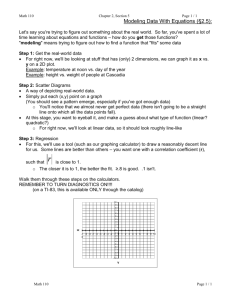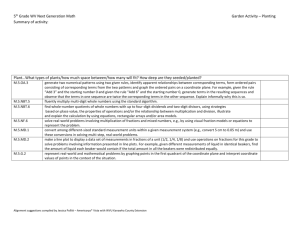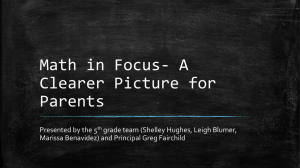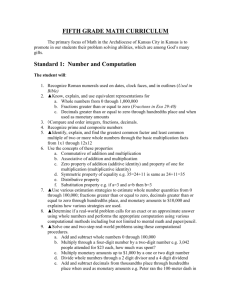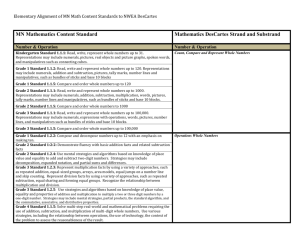Math Across the Grades
advertisement
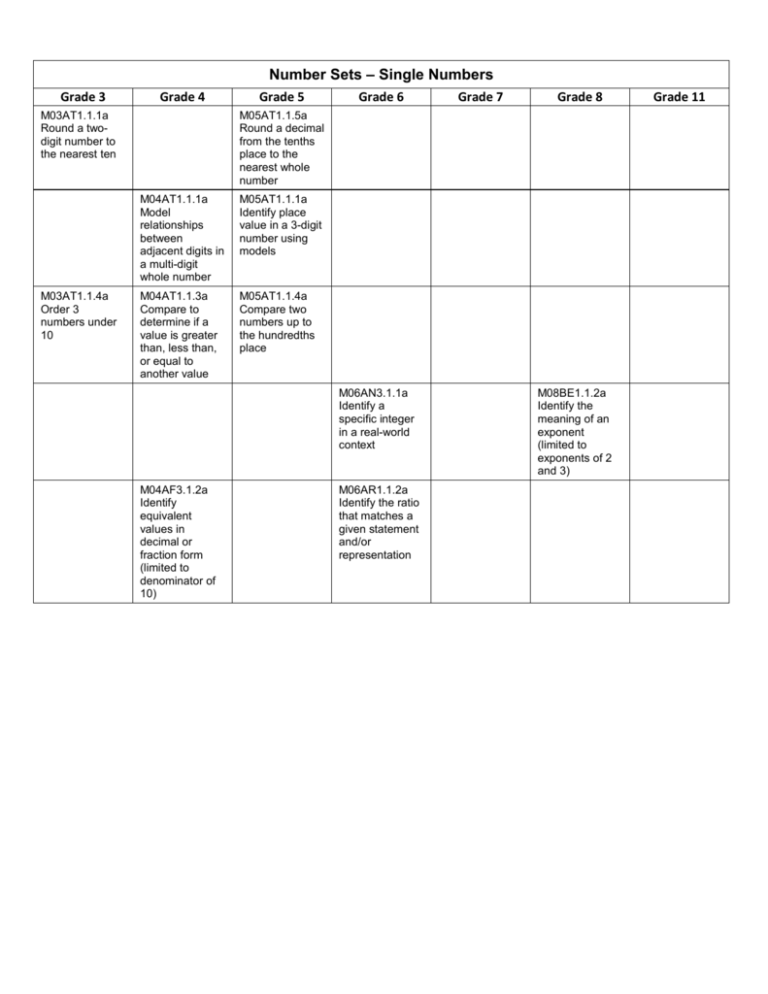
Number Sets – Single Numbers Grade 3 Grade 4 M03AT1.1.1a Round a twodigit number to the nearest ten M03AT1.1.4a Order 3 numbers under 10 Grade 5 Grade 6 Grade 7 Grade 8 M05AT1.1.5a Round a decimal from the tenths place to the nearest whole number M04AT1.1.1a Model relationships between adjacent digits in a multi-digit whole number M05AT1.1.1a Identify place value in a 3-digit number using models M04AT1.1.3a Compare to determine if a value is greater than, less than, or equal to another value M05AT1.1.4a Compare two numbers up to the hundredths place M06AN3.1.1a Identify a specific integer in a real-world context M04AF3.1.2a Identify equivalent values in decimal or fraction form (limited to denominator of 10) M06AR1.1.2a Identify the ratio that matches a given statement and/or representation M08BE1.1.2a Identify the meaning of an exponent (limited to exponents of 2 and 3) Grade 11 Fractions – Single Numbers Grade 3 Grade 4 Grade 5 Grade 6 Grade 7 Grade 8 Grade 11 M03CG1.1.3a Partition a rectangle into parts with equal areas M03AF1.1.1a Identify the unit fraction or other proper fraction (denominators = 2, 3, 4, 6) that matches the representation M04AF.2.1.2a Decompose a proper fraction into multiple copies of a unit fraction (denominators limited to 3, 4, or 8) M03AF1.1.3b Identify equivalent fractions using representations M04AF1.1.1a Identify equivalent fractions M04AF1.1.2a Compare two fractions with like denominators M04AF.2.1.1a Add or subtract fractions with common denominators (denominators limited to 2, 3, 4, or 8) M06AR1.1.5a Calculate a percent of a quantity as a rate per 100 M06AR1.1.4a Solve a 1-step real-world problem given the unit rate M08AN1.1.2a Convert a fraction to a decimal up to the hundredths place M07AR1.1.1a Find the unit rate in a real-world problem CC.2.1.HSF2a Convert between fractions and decimals in a real-world problem Operations with 2 Numbers Grade 3 M03AT1.1.2a Demonstrate understanding of addition with small sets M03AT1.1.2b Demonstrate understanding subtraction with small sets Grade 4 M04AT2.1.1a Add or subtract whole numbers with sums and differences <1000 Grade 5 Grade 6 Grade 7 M05AT2.1.3a Add or subtract decimals to the tenths place M06AN2.1.1a Solve a problem using up to 3digit whole numbers and any of the four operations M07AN1.1.1a Solve a 1-step addition or subtraction problem with fractions, decimals, or positive/negative integers M04AT2.1.4a Assess the plausibility of results from addition or subtraction M03BO1.1.1a Use a model in a multiplication situation M04AT2.1.2a Demonstrate understanding of multiplication or division with small sets M07BE2.3.1a Identify a reasonable solution in the context of a problem using the four basic operations and numbers under 20 M05AT2.1.1a Multiply singledigit whole numbers M05.AF.2.1.2.a Multiply a fraction by a whole number less than 10 M07AN1.1.3a Solve a multiplication or division problem with positive/negative rational numbers Grade 8 Grade 11 This is intentionally left blank because the grade level standards no longer focus on performing operation on only two digits for the purpose of understanding the operation. Operations are applied through the use of expression, equations, functions, data, and other grade level content. Application of Operations with 2 Numbers Grade 3 Grade 4 Grade 5 M03BO3.1.1a Solve a 1-step real-world problem involving numbers under 10 using addition or subtraction M04BO1.1.3a Solve a realworld problem with one or more steps using addition or subtraction M05AF1.1.1a Add or subtract proper fractions with common denominators to solve a realworld problem M04BO1.1.2a Use a model to solve a realworld multiplication problem Grade 6 Grade 7 M07AR1.1.6a Use percentages to solve a realworld problem M05AT2.1.2a Illustrate the concept of division using fair and equal shares Grade 8 Grade 11 This is intentionally left blank because the grade level standards no longer focus on performing operation on only two digits for the purpose of understanding the operation. Operations are applied through the use of expression, equations, functions, data, and other grade level content. Building Data Displays Grade 3 M03DM2.1.1a Add information to a pictograph, line plot, or bar graph Grade 4 Grade 5 Grade 6 Grade 7 Grade 8 M04DM2.1.1a Organize data into a pictograph, line plot, or bar graph Grade 11 CC.2.2.HSC1a Determine the missing coordinates in a table of values containing at least 2 complete ordered pairs M05CG1.1.1a Identify an ordered pair (x,y) in quadrant I M05CG1.1.2a Graph an ordered pair (x,y) in quadrant I M06AN3.2.3a Identify points in all four quadrants of the coordinate plane M07AR1.1.3a Represent a proportional relationship on a line graph M08BE3.1.5a Graph a linear equation M08BE2.1.3a Identify the slope and yintercept of a line on a graph M06AN3.1.3a Locate positive and negative numbers on the number line M06AN3.1.2a Identify the opposite of a number on the number line M07AN1.1.2a Identify the difference between two numbers on the number line M08AN1.1.5a Locate a nonterminating decimal at its approximate location on the number line Using Data Displays Grade 3 Grade 4 M04DM2.1.2a Answer a question about data in a pictograph, line plot, or bar graph Grade 5 Grade 6 M05DM2.1.2a Interpret one set of data given in 2 different displays M06DS1.1.3a Compare points in a line plot, histogram, or on a number line Grade 7 Grade 8 Grade 11 M07DS2.1.1a Compare two sets of data within a single pictograph, line plot, or bar graph M08BE2.1.1a Compare two proportional relationships shown in graph form M07AR1.1.5a Interpret an ordered pair in a real-world problem M08BF2.1.1a Determine the missing value in a graph showing a real-world linear relationship CC.2.2.HSC5b Interpret a graphical representation of a linear model in a real-world problem M08BF2.1.2a Describe the relationship between two variables with a linear relationship displayed in graph form CC.2.2.HSC3a Describe the linear relationship between two variables displayed in a table of values M08DS1.1.2a Identify a statement that describes the relationship between variables displayed in a scatterplot M08DS1.2.1a Answer a question using data from a twoway table CC.2.4.HSB5a Draw a conclusion about data presented in a two-way table representing a real-world problem Number Patterns Grade 3 Grade 4 Grade 5 Grade 6 Grade 7 Grade 8 Grade 11 M03BO3.1.5a Identify a mathematical pattern in a realworld problem M03BO3.1.5b Identify the 3 next terms in a mathematical pattern (increasing by 2, 5 or 10) M04BO3.1.1a Extend a pattern when shown a model and told the rule M05BO2.1.1a Identify and extend numeric patterns M05BO2.1.1b Generate a pattern that follows 1 or more rules provided M04BO2.1.1a Identify the multiples of 5 to 100 and 10 to 100 (e.g., count money) M05AT1.1.2a Identify a pattern and change in place value when a number up to 99 is multiplied by powers of 10 M06AN2.2.1a Identify multiples for numbers 5, 10, 25, or 100 This is intentionally left blank because the grade level standards shift from numerical patterns to expressions, equations, and functions. Expressions, Equations, and Functions Grade 3 Grade 4 Grade 5 Grade 6 Grade 7 Grade 8 Grade 11 CC.2.2.HSD7a Translate a realworld problem into a onevariable equation M06BE2.1.2a Select an algebraic expression involving addition or subtraction of whole numbers to solve a 1-step real-world problem This is intentionally left blank because the grade level standards establish these early concepts/procedures through the idea of numerical patterns. M06BE2.1.3a Use a 1-step algebraic expression to solve a realworld problem involving addition or subtraction of whole numbers M07BE2.2.1a Select an algebraic expression (equations or inequalities) using addition or subtraction of fractions, decimals, or positive/negative integers to solve a 1-step realworld problem M08BE3.1.1a Select an algebraic equation using addition or subtraction to solve a 2-step real-world problem with one variable CC.2.2.HSD1a Select an algebraic expression using any of the four operations and solve a realworld problem M08BE3.1.2a Solve a 2-step real-world problem using an algebraic equation involving addition or subtraction and one variable CC.2.2.HSD8a Solve a linear equation to find a missing attribute when determining area or volume CC.2.2.HSD9a Order a given sequence of steps to solve an equation M06BE3.1.1a Identify the relationship between two variables in an equation CC.2.4.HSB3a Identify the relationship between two or more variables in a function CC.2.2.HSC5a Interpret the effect of a change in one variable on the other variable using graphs or tables Geometric Figures Grade 3 M03CG1.1.1a Identify similarities between two polygons Grade 4 M04CG1.1.2a Classify twodimensional shapes based on attributes M04CG1.1.3a Recognize a line of symmetry in a two-dimensional figure M03DM3.1.2a Measure the area of a rectangle by counting squares, tiling, or addition M03DM4.1.1a Find the perimeter of a rectangle M04DM1.1.3a Identify the area or perimeter of a rectangle Grade 5 Grade 6 Grade 7 Grade 8 Grade 11 M05CG2.1.1a Identify a twodimensional figure with specific attributes M06CG1.1.5a Classify threedimensional figures M07CG1.1.4a Identify a threedimensional figure with specific attributes M08CG1.1.1a Identify a rotation, reflection, or translation of a two- or threedimensional figure CC.2.3.HSA13a Match corresponding two-dimensional and threedimensional representations M05DM3.1.2a Find volume by using filling or multiplication M06CG1.1.3a Solve a realworld problem involving volume using unit cubes or multiplication M07CG2.2.2a Find the area or volume of a twoor threedimensional object given the formula M08CG.3.1.1a Complete the formula for volume to solve a real-world or mathematical problem CC.2.3.HSA14a Compare the area of two objects with one equivalent attribute M07CG1.1.2a Identify the properties of a right triangle M08CG2.1.2a Apply the Pythagorean theorem to determine length/distance in a real-world problem M07CG2.1.1a Use angle relationships to find the missing angle M08CG1.1.2a Identify figures that are congruent/similar M06CG1.1.1a Find the area of a quadrilateral given the dimensions Measurement Grade 3 Grade 4 Grade 5 M04DM1.1.1a Identify the appropriate unit of measurement in a real-world problem M05DM1.1.1a Use a conversion table to identify equivalent standard measurements of length or mass Grade 6 Grade 7 Grade 8 Grade 11 M03DM1.1.1a Tell time to the hour or half hour on a clock M03DM1.2.1a Identify and use the appropriate measurement tool based on the situation M07CG1.1.1a Solve a 1-step real-world problem related to scaling CC.2.1.HSF3a Identify and interpret scale in a real-world problem M03DM1.2.3a Use a ruler and measure to the nearest inch (exact measurement) M03DM1.3.1a Count money using coins or one-dollar bills CC.2.1.HSF4a Determine the necessary units and solve a realworld problem M06DS1.1.2a Identify measures of central tendency (mean, median, mode) M07DS2.1.1b Use measures of central tendency to interpret data, including overall patterns in the data CC.2.4.HSB2a Interpret the means and/or medians of two sets of data M07DS3.1.1a Identify the probability of events occurring as possible/impossi ble or likely/unlikely CC.2.4.HSB7a Identify the probability of events based on real-world examples of conditional probability
